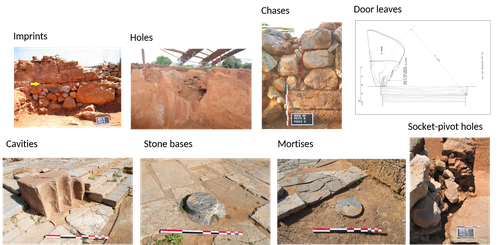
HANNA Jonathan
- Archaeologist, Richard Grubb & Associates, Inc., Cranbury, NJ, United States
- Archaeometry, Computational archaeology, Dating, Environmental archaeology, Geoarchaeology, North America, Paleoenvironment, Palynology, Peopling, Protohistory, Remote sensing, Rock art, South America, Spatial analysis, Taphonomy, Theoretical archaeology
- recommender
Recommendations: 3
Reviews: 0
Recommendations: 3

Analysis of the Abundance of Radiocarbon Samples as Count Data
Beyond the Sum: A Poisson Approach to Radiocarbon Analysis
Recommended by Jonathan Hanna based on reviews by Thomas Huet and 1 anonymous reviewerArchaeological data is inherently uncertain, which is probably why Bayesian approaches have become increasingly valued within the discipline. For radiocarbon analysis, instead of pinpointing one "true" date, Bayesian methods embrace probability, telling us how likely a sample falls within different date ranges based on what we already know (the prior) and what our data tells us (the posterior).
In this new paper, Miguel de Navascués and colleagues offer a method for treating radiocarbon dates as count data (generated through a Poisson process), rather than viewing them as draws from a probability distribution. This shift allows them to model the expected number of samples per year and incorporate uncertainty in both the timing and total number of samples. The result is a more natural representation of how radiocarbon samples accumulate in the archaeological record over time. (They then demonstrate the method using data from Britain and Ireland, revealing patterns that both confirm and refine our understanding of population changes during key transitions, including a possibly earlier start to the Neolithic demographic expansion.)
Overall, the paper represents a valuable contribution to quantitative archaeology that complements, rather than replaces, existing approaches like Sum Probability Distributions (SPDs) and end-to-end Bayesian methods (e.g., see Crema 2022 and Price et al. 2021).
While mathematically heavy, the paper is accompanied by well-annotated R scripts that I encourage readers to experiment with. For researchers working with radiocarbon data, particularly those investigating demographic change or cultural transmission, the methods presented here offer important new analytical possibilities for understanding past human dynamics. Sometimes, to move forward, we just need to count differently.
References
Crema, E. R. (2022), Statistical Inference of Prehistoric Demography from Frequency Distributions of Radiocarbon Dates: A Review and a Guide for the Perplexed. Journal of Archaeological Method and Theory 29(4):1387–1418. https://doi.org/10.1007/s10816-022-09559-5
de Navascués, M., Burgarella, C. & Jakobsson, M. (2025) Analysis of the Abundance of Radiocarbon Samples as Count Data. Zenodo, ver.3 peer-reviewed and recommended by PCI Archaeology https://doi.org/10.5281/zenodo.13381596
Price, M. H., Capriles, J. M., Hoggarth, J. A., Bocinsky, R. K., Ebert, C. E. & Jones, J. H. (2021) End-to-End Bayesian Analysis for Summarizing Sets of Radiocarbon Dates. Journal of Archaeological Science 135:105473. https://doi.org/10.1016/j.jas.2021.105473

Dealing with post-excavation data: the Omeka S TiMMA web-database
Managing Archaeological Data with Omeka S
Recommended by Jonathan Hanna based on reviews by Electra Tsaknaki and 1 anonymous reviewerManaging data in archaeology is a perennial problem. As the adage goes, every day in the field equates to several days in the lab (and beyond). For better or worse, past archaeologists did all their organizing and synthesis manually, by hand, but since the 1970s ways of digitizing data for long term management and analysis have gained increasing attention [1]. It is debatable whether this ever actually made things easier, particularly given the associated problem of sustainable maintenance and accessibility of the data. Many older archaeologists, for instance, still have reels and tapes full of data that now require a new form of archaeology to excavate (see [2] for an unrealized idea on how to solve this).
Today, the options for managing digital archaeological data are limited only by one’s imagination. There are systems built specifically for archaeology, such as Arches [3], Ark [4], Codifi [5], Heurist [6], InTerris Registries [7], OpenAtlas [8], S-Archeo [9], and Wild Note [10], as well as those geared towards museum collections like PastPerfect [11] and CatalogIt [12], among others. There are also mainstream databases that can be adapted to archaeological needs like MS Access [13] and Claris FileMaker [14], as well as various web database apps that function in much the same way (e.g., Caspio [15], dbBee [16], Amazon's Simpledb [17], Sci-Note [18], etc.) — all with their own limitations in size, price, and utility. One could also write the code for specific database needs using pre-built frameworks like those in Ruby-On-Rails [19] or similar languages. And of course, recent advances in machine-learning and AI will undoubtedly bring new solutions in the near future.
But let’s be honest — most archaeologists probably just use Excel. That's partly because, given all the options, it is hard to decide the best tool and whether its worth changing from your current system, especially given few real-world examples in the literature. Bastien Rueff’s new paper [20] is therefore a welcomed presentation on the use of Omeka S [21] to manage data collected for the Timbers in Minoan and Mycenaean Architecture (TiMMA) project. Omeka S is an open-source web-database that is based in PHP and MySQL, and although it was built with the goal of connecting digital cultural heritage collections with other resources online, it has been rarely used in archaeology. Part of the issue is that Omeka Classic was built for use on individual sites, but this has now been scaled-up in Omeka S to accommodate a plurality of sites.
Some of the strengths of Omeka S include its open-source availability (accessible regardless of budget), the way it links data stored elsewhere on the web (keeping the database itself lean), its ability to import data from common file types, and its multi-lingual support. The latter feature was particularly important to the TiMAA project because it allowed members of the team (ranging from English, Greek, French, and Italian, among others) to enter data into the system in whatever language they felt most comfortable.
However, there are several limitations specific to Omeka S that will limit widespread adoption. Among these, Omeka S apparently lacks the ability to export metadata, auto-fill forms, produce summations or reports, or provide basic statistical analysis. Its internal search capabilities also appear extremely limited. And that is not to mention the barriers typical of any new software, such as onerous technical training, questionable long-term sustainability, or the need for the initial digitization and formatting of data. But given the rather restricted use-case for Omeka S, it appears that this is not a comprehensive tool but one merely for data entry and storage that requires complementary software to carry out common tasks.
As such, Rueff has provided a review of a program that most archaeologists will likely not want or need. But if one was considering adopting Omeka S for a project, then this paper offers critical information for how to go about that. It is a thorough overview of the software package and offers an excellent example of its use in archaeological practice.
NOTES
[1] Doran, J. E., and F. R. Hodson (1975) Mathematics and Computers in Archaeology. Harvard University Press.
[2] Snow, Dean R., Mark Gahegan, C. Lee Giles, Kenneth G. Hirth, George R. Milner, Prasenjit Mitra, and James Z. Wang (2006) Cybertools and Archaeology. Science 311(5763):958–959.
[3] https://www.archesproject.org/
[4] https://ark.lparchaeology.com/
[5] https://codifi.com/
[6] https://heuristnetwork.org/
[7] https://www.interrisreg.org/
[8] https://openatlas.eu/
[9] https://www.skinsoft-lab.com/software/archaelogy-collection-management
[10] https://wildnoteapp.com/
[11] https://museumsoftware.com/
[12] https://www.catalogit.app/
[13] https://www.microsoft.com/en-us/microsoft-365/access
[14] https://www.claris.com/filemaker/
[15] https://www.caspio.com/
[16] https://www.dbbee.com/
[17] https://aws.amazon.com/simpledb/
[18] https://www.scinote.net/
[19] https://rubyonrails.org/
[20] Rueff, Bastien (2023) Dealing with Post-Excavation Data: The Omeka S TiMMA Web-Database. peer-reviewed and recommended by Peer Community in Archaeology. https://zenodo.org/records/7989905
[21] https://omeka.org/

Technological analysis and experimental reproduction of the techniques of perforation of quartz beads from the Ceramic period in the Antilles
Using Cactus Thorns to Drill Quartz: A Proof of Concept
Recommended by Donatella Usai and Jonathan Hanna based on reviews by Viola Stefano, ? and 1 anonymous reviewerQuartz adornments (beads, pendants, etc.) are frequent artifacts found in the Caribbean, particularly from Early Ceramic Age contexts (~500 BC-AD 700). As a form of specialization, these are sometimes seen as indicative of greater social complexity and craftsmanship during this time. Indeed, ethnographic analogy has purported that such stone adornments require enormous inputs of time and labor, as well as some technological sophistication with tools hard-enough to create the holes (e.g., metal or diamonds). However, given these limitations, one would expect unfinished beads to be a common artifact in the archaeological record. Yet, whereas unworked/raw materials are often found, beads with partial/unfinished perforations are not.
Could the perforations of stone beads be made using more accessible materials? Some ethnographic sources from Central America suggest certain plant materials could work. Thus, Raymond et al. (2022) endeavored to test the manufacturing process of stone beads by experimenting with several underrated (yet readily available) materials from the Caribbean: various species of wood, bone, thorns, and chert. As it turns out, thorns from an endemic cactus (Melocactus intortus) worked best and were actually harder than many of the other materials attempted. Even the chert drills were too large and fragile to be effective (neither are they found archaeologically). Using debitage powder from the rock itself, some water, and a basic bow drill mounted with a cactus thorn, the team successfully created perforations on unworked samples of quartz that were similar to those found archaeologically. This was corroborated by analyzing the results at different levels of magnification, including X-ray microtomography and SEM, and then comparing that to similar studies on ancient beads.
The results of this study offer useful parameters for the feasibility of bead craftsmanship in the ancient Caribbean. For one, all of the materials used are fairly common in the region, including quartz (although the source of amethyst in the Caribbean is believed to be Guyana (Cody 1990)). Additionally, the practice does not require much skill, as the authors (neophyte craftspeople) were able to replicate the holes. Presumably, a child could do this (an intriguing prospect). The study therefore offers practical data for the once mysterious production of precolumbian personal adornments. Indeed, the article indirectly offers arguments for the presence of bead crafting specialists in other areas of the world as well, where production of ornaments entails similar time investments and complexity. For example, similar quartz materials, like carnelian or agate, shaped into long barrels or cylindrical beads forming beautiful parures, are common to pre-metallic contexts of agro-pastoral societies of Europe and North Africa in the VI and V millennium BC.
That said, the huge time commitment (over 200 hours per bead), although far less than the years (or lifetimes) some researchers had previously estimated, socially translates into a distraction from subsistence activities, which may indicate the presence of individuals devoted (at least part-time) to producing non-utilitarian adornments (see also Kenoyer et al. 1991 on this topic).
Focusing on the specific aspect of finding the most appropriate substitute to metal piercing devices and the related aspects of the overall chaîne opératoire, the document invites further research, for example on the bead locking system during the piercing phase, in the management of the force exerted during the process, and in the number of failures (and on their potential uses).
References:
Raymond, M., Fouéré, P., Ledevin, R., Lefrais, Y., and Queffelec, A. (2022) Technological analysis and experimental reproduction of the techniques of perforation of quartz beads from the Ceramic period in the Antilles. SocArXiv, a5tgp, ver. 4 peer-reviewed and recommended by Peer Community in Archaeology. https://osf.io/preprints/socarxiv/a5tgp
Cody, A.K. (1990) Prehistoric patterns of exchange in the Lesser Antilles: materials, models, and preliminary observations. PhD thesis, San Diego State University.
Kenoyer, J.M., Vidale, M. and Bhan, K.K. (1991) Contemporary stone bead-making in Khambhat, India: Patterns of craft specialization and organization of production as reflected in the archaeological record. World Archaeology 23 (1), 44-63. https://doi.org/10.1080/00438243.1991.9980158